Getting Started
 1-2-4-All provides the foundation for many other Liberating Structures. It is a very good place to get started.
1-2-4-All provides the foundation for many other Liberating Structures. It is a very good place to get started.
The detailed narrative below explores how to bring this microstructure into practice. Additionally, we recommend that you work with a partner who is able to observe and give you candid feedback about first efforts.
We know that the group is smarter than any single individual. The challenge is how to tap into a group’s collective intelligence and creativity when discussing an issue. It is also vital to prevent a conversation dominated by a couple of people and avoid a discussion that goes on, and on, and on?
1-2-4-All is one of the most effective methods and can be used by anyone for groups of any size.
1-2-4-All is so simple that it is one of the easiest LS to learn. The structural changes it introduces have a surprisingly big impact on group discussions. Since nearly all meetings routinely include group discussions the opportunities for using 1-2-4-All are extremely frequent. Try it once and you will know enough to start using this LS regularly.
1-2-4-All breaks down discussions into steps that allow participants to contribute individually and work together at the top of their intelligence: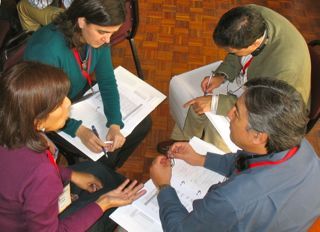
(1) One moment alone (1) to reflect: for instance in response to a question or in reaction to a presentation, writing down responses or ideas. The moment is short on the order of one or two minutes.
(2) A few minutes in pairs (2) to share, compare, improve or expand on the individual ideas. The time varies from two to five minutes depending on circumstances.
(4) A few more minutes for pairs assembled in foursomes (4) to share and further develop the pairs’ ideas. Time again is variable from two to five minutes.
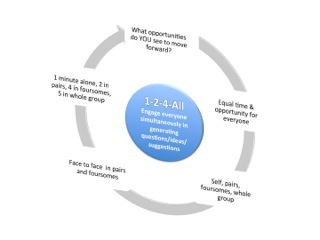 (All) During the last step, any foursome can share one important idea or question that the whole group should hear (there is no need for each group to report out). Conclusions, decisions, or actions are made based on what emerges.
(All) During the last step, any foursome can share one important idea or question that the whole group should hear (there is no need for each group to report out). Conclusions, decisions, or actions are made based on what emerges.
 Bells signal transitions in rapid cycle 1-2-4-All conversationsThe whole cycle can be as short as ten minutes and shouldn’t be longer than 15 minutes. If the issue warrants more time it is much more productive to do a second cycle rather than let the steps last too long. In other words more will be accomplished with two rapid cycles of 10 minutes than with one cycle of 20 minutes because the second cycle benefits from the whole group sharing at the end of the first cycle.
Bells signal transitions in rapid cycle 1-2-4-All conversationsThe whole cycle can be as short as ten minutes and shouldn’t be longer than 15 minutes. If the issue warrants more time it is much more productive to do a second cycle rather than let the steps last too long. In other words more will be accomplished with two rapid cycles of 10 minutes than with one cycle of 20 minutes because the second cycle benefits from the whole group sharing at the end of the first cycle.
Alternatively one 1-2-4-All cycle can be followed by another cycle using a different Liberating Structure.
Why does 1-2-4-All elevate groups discussions to a higher level?
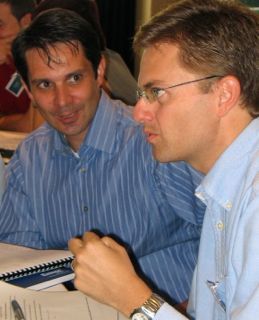 The first fundamental difference from the usual group discussion is that 1-2-4-All gives everyone present an equal opportunity to contribute. All the silent thoughts that otherwise would stay in people’s head can be spoken out loud, starting with the individual reflection time, a rare opportunity to collect one’s thoughts without disturbance.
The first fundamental difference from the usual group discussion is that 1-2-4-All gives everyone present an equal opportunity to contribute. All the silent thoughts that otherwise would stay in people’s head can be spoken out loud, starting with the individual reflection time, a rare opportunity to collect one’s thoughts without disturbance.
Moving on to a pair formation provides as safe a space as possible for each to articulate these thoughts for the first time, get feedback and hear one other person’s point of view. Creating safe spaces for expression (versus asking people to take the risk of speaking up in front of a whole group that almost always includes someone with more positional power) transforms both the amount and, most important, the diversity of ideas expressed.
After the second step, ideas, especially those controversial ones, can be more safely presented as emanating from a group rather than a single individual, thus liberating many views that otherwise would never come to the surface.
As you move from one to two to four people the progressive nature of the conversation provides both time and repetition for greater depth and meaning to develop. Quality improves as ideas get safely bounced around in pairs and foursomes. Repetition is a source of novelty.
The next benefit of the 1-2-4 sequence is that it distributes time and space regardless of personality. The more timid individuals can express themselves comfortably at the minimum during the 1-2 steps. The most vocal participants can only dominate the conversation in their own pair or foursome. This breaks down the pattern of meeting discussions that are frequently monopolized by two or three individuals.
Another difference is that 1-2-4-All reduces dysfunctional discussions by reducing the amount of cognitive multitasking. In standard group discussions people are expected to think and listen or think and talk at the same time while jostling for space to be heard. Listening is usually the first casualty closely followed by thinking as people tend to focus on advocating their position.
What happens in typical discussions is that contributions jump from one person to another. Some participants are very long winded. Some participants don’t say a word. Information is often missing and has to be assumed because the people who really know (usually those close to the action) are not in the room. Talking/presenting widely exceeds the attention span of participants. If participants sense that the final outcome is preordained, participation fades.
 1-2-4-All creates favorable conditions for group intelligence or creativity to emerge because it allows the creation of lots of small pieces during the first three steps.
1-2-4-All creates favorable conditions for group intelligence or creativity to emerge because it allows the creation of lots of small pieces during the first three steps.
During the last step the whole groups collects the pieces little by little and starts fitting them together like pieces of a puzzle. The big difference here is that everybody can see and hear all the pieces contributed by everybody.
What is made possible?
Better ideas and more of them are generated. Solutions, conclusions or decisions are reached faster than ever before. Open, generative conversations unfold. Ideas are sifted in rapid fashion. Groups much larger than what is feasible with a standard format can be engaged in effective discussions. Participation as wide and diverse as any issue requires becomes possible.
Most important, implementation becomes greatly simplified and accelerated because all share ownership of the ideas and decisions that have been co-developed. No need to explain and convince! No need to twist arms with buy-in strategies!
At the other end of the range even a group of four people will significantly improve their discussions by using the three steps of 1-2-4. The rhythm and the depth of their discussions are guaranteed to change. 1-2-4-All can be used powerfully with groups of four to one thousand. More details here.
As you get started, we recommend that you work with a partner. Invite your partner to observe and help you keep track of opportunties that pop up. The following steps help you to improve your practice very quickly. A deeper dive into LS facilitation here.
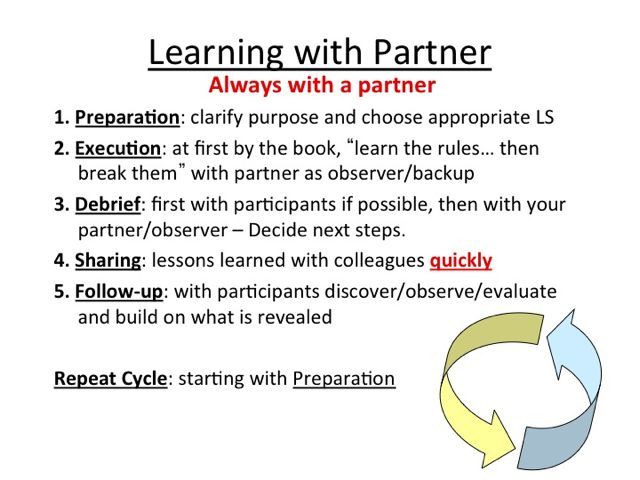
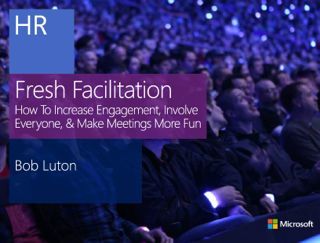 Introducing Liberating Structures to other facilitators, leaders, and front line folks helps to quickly spread your early success. Bob Luten at Microsoft created a wonderful introduction for colleagues in India. They loved it and made plans to immediately use the microstructures in their everyday work. Check out his presenation materials here.
Introducing Liberating Structures to other facilitators, leaders, and front line folks helps to quickly spread your early success. Bob Luten at Microsoft created a wonderful introduction for colleagues in India. They loved it and made plans to immediately use the microstructures in their everyday work. Check out his presenation materials here.
For more information about immersion workshops contact Keith McCandless or Henri Lipmanowicz.
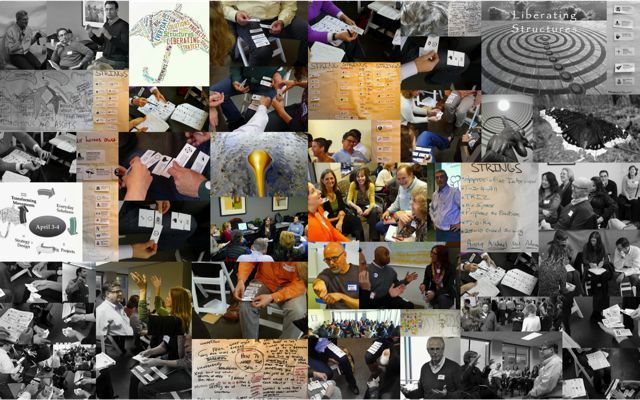 Highlights from the 4 part Seattle Immersion workshops
Highlights from the 4 part Seattle Immersion workshops
Just beyond the beginning, users create memory joggers for Liberating Structures.
After a workshop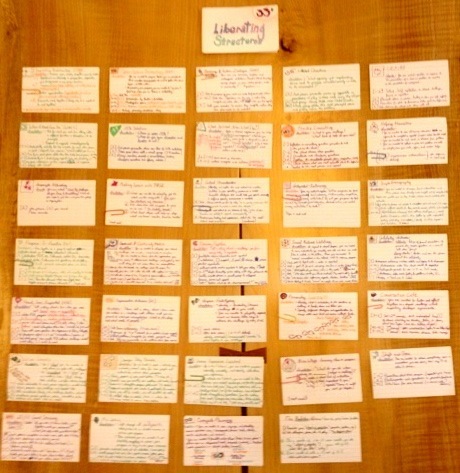 Shawn’s cards include the Structured Invitation, timing and key steps., Shawn Henning (Sr. Quality Assurance Engineer @ Deloitte Digital) created a full set of 33 illustrated 3 by 5 index cards. Each with just the Min Specs for "how to" put a LS microstructure into practice.
Shawn’s cards include the Structured Invitation, timing and key steps., Shawn Henning (Sr. Quality Assurance Engineer @ Deloitte Digital) created a full set of 33 illustrated 3 by 5 index cards. Each with just the Min Specs for "how to" put a LS microstructure into practice.
Shawn mentioned that creating cards was a powerful learning approach in and of itself, helping him feel more prepared to use LS improvisationally as opportunities arrive.
 Detail of the Ecocycle index card / memory jogger
Detail of the Ecocycle index card / memory jogger
Would you like to listed as a LS facilitator or user? Registering can make it easy for others with an interested in Liberating Structures to find you.
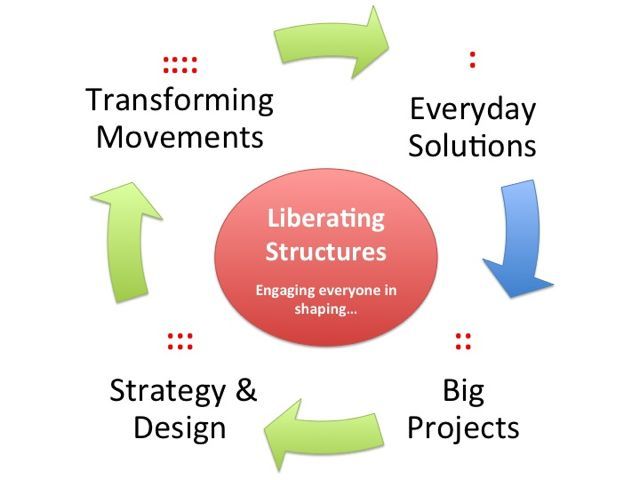 Focusing on how everyday solutions are generated builds capacity for success with big projects, design initiatives, and strategic transformations
Focusing on how everyday solutions are generated builds capacity for success with big projects, design initiatives, and strategic transformations
